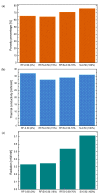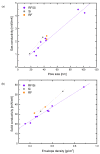Hybrid RF-Si Xerogels: A Cost-Effective Proposal for Insulator Materials
- PMID: 35009412
- PMCID: PMC8745971
- DOI: 10.3390/ma15010265
Hybrid RF-Si Xerogels: A Cost-Effective Proposal for Insulator Materials
Abstract
Hybrid xerogels RF/Si were synthesized by controlling the chemical variables involved in the polymerization process (i.e., molar ratios, dilution ratio, catalysts, etc.) and evaluated as insulator materials. Higher insulating performances were recorded for these hybrids compared with their counterparts made from only one of their components (i.e., RF or Si xerogels with similar porous characteristics). The analysis of chemical and structural features correlated with heat transfer methods was useful in understanding the sum of contributions involved in the thermal conductivity of RF/Si xerogels. Variables such as roughness and tortuosity can be used to improve the performance of xerogels from a different perspective. In this way, thermal conductivities of 25 mW/mK were achieved without lengthy process steps or special drying methods. Knowledge of material design and the use of microwave heating during the synthesis allowed us to approach a simple and cost-effective process. These results suggest that the hybrid materials developed in this work are a good starting point for the future of the massive production of insulation materials.
Keywords: cost-effective process; hybrid xerogels; microwave heating; thermal insulation.
Conflict of interest statement
The authors declare no conflict of interest.
Figures







Similar articles
-
Towards a feasible and scalable production of bio-xerogels.J Colloid Interface Sci. 2015 Oct 15;456:138-44. doi: 10.1016/j.jcis.2015.06.024. Epub 2015 Jun 18. J Colloid Interface Sci. 2015. PMID: 26119083
-
Fast microwave-assisted synthesis of tailored mesoporous carbon xerogels.J Colloid Interface Sci. 2011 May 15;357(2):541-7. doi: 10.1016/j.jcis.2011.02.034. Epub 2011 Feb 18. J Colloid Interface Sci. 2011. PMID: 21392777
-
Mechanically Strong, Scalable, Mesoporous Xerogels of Nanocellulose Featuring Light Permeability, Thermal Insulation, and Flame Self-Extinction.ACS Nano. 2021 Jan 26;15(1):1436-1444. doi: 10.1021/acsnano.0c08769. Epub 2021 Jan 6. ACS Nano. 2021. PMID: 33405895
-
Silicone-Based Organic-Inorganic Hybrid Aerogels and Xerogels.Chemistry. 2017 Apr 19;23(22):5176-5187. doi: 10.1002/chem.201603680. Epub 2017 Jan 20. Chemistry. 2017. PMID: 28105748 Review.
-
Nanocellulose-based lightweight porous materials: A review.Carbohydr Polym. 2021 Mar 1;255:117489. doi: 10.1016/j.carbpol.2020.117489. Epub 2020 Dec 13. Carbohydr Polym. 2021. PMID: 33436249 Review.
Cited by
-
Novel Silica Hybrid Xerogels Prepared by Co-Condensation of TEOS and ClPhTEOS: A Chemical and Morphological Study.Gels. 2022 Oct 20;8(10):677. doi: 10.3390/gels8100677. Gels. 2022. PMID: 36286178 Free PMC article.
References
-
- Thapliyal P.C., Singh K. Aerogels as Promising Thermal Insulating Materials: An Overview. J. Mater. 2014;2014:127049. doi: 10.1155/2014/127049. - DOI
-
- Cuce E., Cuce P.M., Wood C.J., Riffat S.B. Toward aerogel based thermal superinsulation in buildings: A comprehensive review, Renew. Sustain. Energy Rev. 2014;34:273–299. doi: 10.1016/j.rser.2014.03.017. - DOI
-
- Koebel M., Rigacci A., Achard P. Aerogel-based thermal superinsulation: An overview. J. Sol-Gel Sci. Technol. 2012;63:315–339. doi: 10.1007/s10971-012-2792-9. - DOI
-
- Boeri A., Antonini E., Gaspari J., Longo D. Energy Design Strategies for Retrofitting: Methodology, Technologies and Applications. WIT Press; Southampton Boston, MA, USA: 2015.
Grants and funding
- PCI2020-112039 MCIN/AEI-10.13039/501100011033/Ministerio de Ciencia e Innovación from Spain and the Eurpean Union NextGeneration EU/PRTR
- PID2020-113001RB-I00 MCIN/AEI-10.13039/501100011033/Ministerio de Ciencia e Innovación from Spain and the Eurpean Union NextGeneration EU/PRTR
- IJC2019-040875-I/Ministerio de Ciencia e Innovación
- "Severo Ochoa" program/Administración del Principado de Asturias
LinkOut - more resources
Full Text Sources

